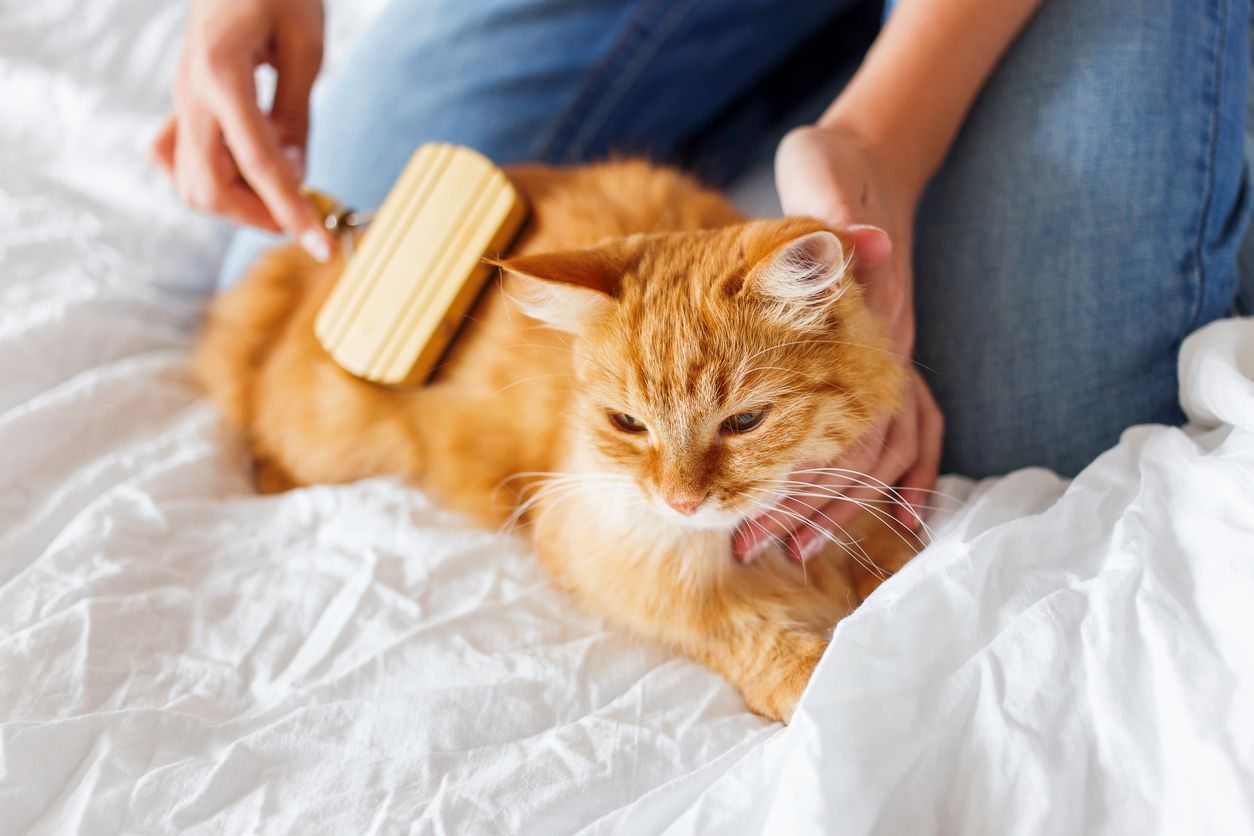Are my cat's frequent hairballs normal?

It is a common misconception that hairballs are a normal and common occurrence in cats. Frequent hairballs indicate your cat has an underlying health condition and needs veterinary attention. Read on to learn:
- Why do cats get hairballs?
- What do hairballs look like?
- Are hairballs dangerous?
- Can I help my cat’s hairballs?
Ingested hair clumps in the intestinal tract can cause unpleasant or deadly symptoms when the digestive tract isn’t functioning properly or can’t keep up. Understanding what causes hairballs and how they can be reduced or eliminated can protect your furry friend, and your carpet, from hairballs in the future.
What are hairballs?
Hairballs, or trichobezoars, are a common condition in pet cats. As cats groom themselves, they ingest loose hair. Fur cannot be digested but can move through a healthy digestive tract. If it cannot move through the intestines, it may end up as a regurgitated wet clump on your floor or, even worse, your carpet. An occasional hairball is a common complaint from pet parents, especially about long-haired breeds. It’s also common for people to worry about hairballs becoming dangerous if they are too large to regurgitate or if they are a frequent occurrence, but the real concern is that hairballs are an indicator of underlying disease.
What causes hairballs in cats?
A cat’s rough tongue has backward-facing barbs that catch fur during grooming. Hairballs occur when a cat ingests too much hair for the gastrointestinal tract (GI tract) to handle or if their gut motility is impaired. No matter the underlying cause, hairballs are not normal in cats, and frequent hairballs are a cause for concern.
How can I tell if my cat has a hairball?
A common description of cat regurgitation is “coughing up a hairball.” However, coughing comes from the respiratory tract (lungs and related structures), while hairballs come from the digestive tract (stomach and intestines). Cat parents should not assume their cat is having a hairball if they are coughing when no hairball is present. It’s also important not to assume your cat has a hairball when they vomit. The only way to know for sure it is a hairball is with the presence of a hairball either on your floor or identified in diagnostic imaging such as X-rays, ultrasound, or endoscopy.
When do hairballs become dangerous for my cat?
If a cat is vomiting up a hairball more than once a week or as a regular occurrence, it’s time to consult a veterinarian. Frequent hairballs signify hair loss, excessive grooming, or underlying digestive tract diseases. Likewise, consult a vet if vomiting occurs more than once a week, even without the presence of a hairball. A hairball too large to be vomited up may become trapped in the GI tract and can cause a GI obstruction. Large hairballs are one of many causes of frequent vomiting. Contact your veterinarian if your cat:
- Has hairballs more than once a week
- Has chronic vomiting, diarrhea, or constipation
- Becomes lethargic
- Has a loss of appetite
Long-haired cats are more likely to have hairballs due to a faster accumulation of fur as they groom.
How can I help my cat with hairballs?
If your cat has frequent hairballs, the first step is to visit a vet. Understanding why your cat has frequent hairballs will help determine how to treat the condition. Numerous conditions can decrease GI motility or increase hair ingestion, so an extensive diagnostic workup may be necessary. Specific treatment options for the different diseases associated with hairballs vary widely, ranging from anti-anxiety medications to chemotherapy.
Depending on the underlying cause of hairballs, removing excess hair through grooming or assisting the mobility of the intestinal tract with extra fiber or lubricants may also be recommended. Evidence supporting their effectiveness is limited, but common hairball treatments include:
- Regular at-home grooming sessions
- Visiting a professional groomer
- Using a comb instead of a brush
- A change in diet
- Gastric lubricant
- Fiber supplementation
If the hairball has caused a GI obstruction, it must be removed with surgery.
Do hairball treats work?
Many treats and cat foods on the market claim to aid with hairballs. These products lack evidence to prove they are of any benefit and are unlikely to help. If your cat struggles with frequent hairballs, discuss the problem with a vet to find an effective solution. Starting with an at-home hairball remedy like pumpkin puree is unlikely to work and delays identifying the real source of the hairballs and determining an effective solution. If you would like to discuss your cat’s hairball situation with a veterinarian, a virtual vet appointment is an excellent option.
FAQ - What do I do if my cat has hairballs?
What types of cats produce the most hairballs?
Long-haired cats, such as Persians and Maine Coons, are the most likely to develop hairballs due to their long fur increasing the amount of hair that ends up in the digestive tract. Regular grooming can help remove excess hair that would otherwise be ingested when a cat grooms itself.
Can hairballs become fatal?
Hairballs are sometimes a symptom of illness, and some of the diseases associated with hairballs can be fatal. Sometimes a large hairball can cause an intestinal blockage. Blockages are medical emergencies and require immediate surgical intervention to remove the hairball.
How can I help my cat pass a hairball?
The treatment for hairballs depends on the underlying cause. A veterinarian visit can help determine why your feline friend has hairballs and how you can help your cat pass the hair it ingests in the future.
How often should cats throw up hairballs?
Despite common belief, hairballs are not normal. Cats should not bring up hairballs more than once a week and should not have hairballs regularly.




